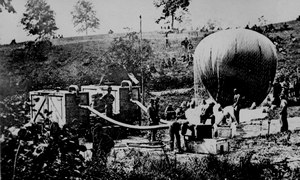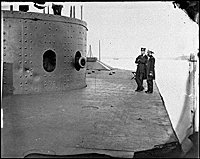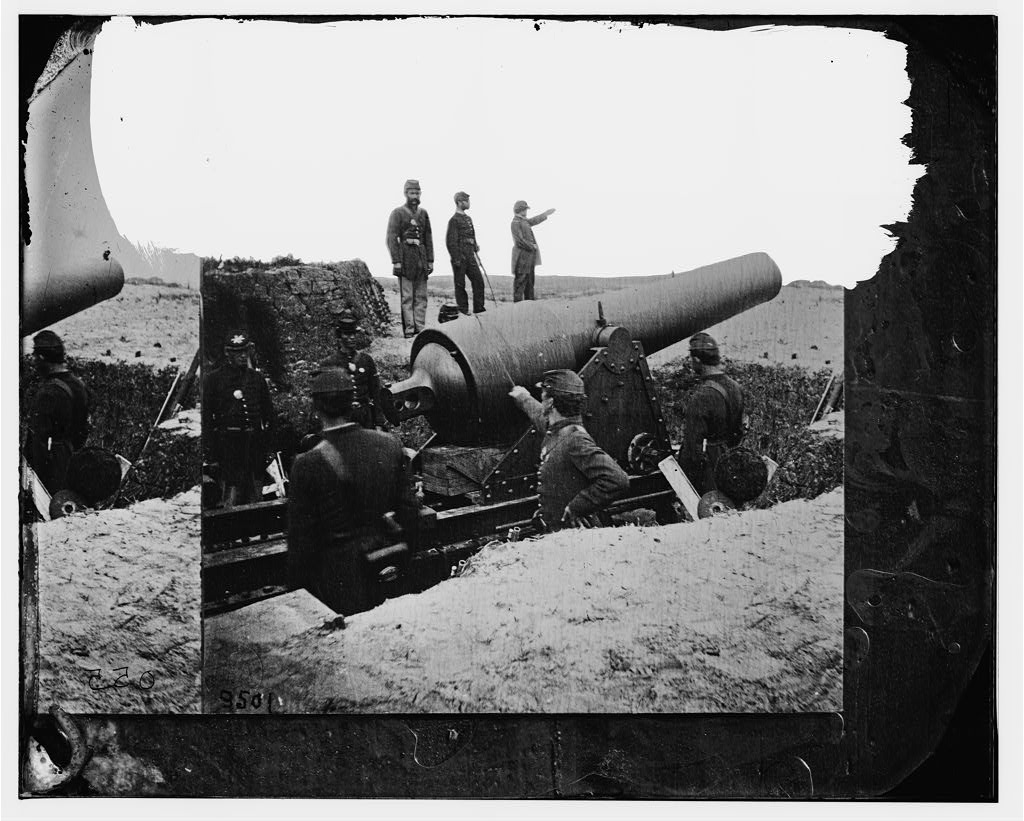Civil War Weapons
In 1861, the belligerents were about to enter the modern era of
weaponized warfare on land, sea and air. The changes altered age old
tactics and severely reduced the rate of survival. On land, accuracy and
increased range of small and large guns emerged. On the sea, iron ships
made wooden navies obsolete. In the air, telegraphy brought the front
lines to the commanders in the rear. Spotters in balloons hovering
over enemy lines, provided their cannon
batteries with eye witness intelligence required to properly calibrate range for
the big guns. Between 1861 and 1865, two hundred years of tactics and weapons were on the cusp of disappearing, and new techniques and technologies would eliminate the old before the turn of the century.
Civil War Weapons
Inventors were encouraged to file patents with fresh ideas that would increase the lethality of weapons. President Abraham Lincoln personally demanded that filing patents be processed rapidly in the hope that some innovation would provide a "magic bullet" to end the war. Some in his cabinet, and many generals in the field, were opposed to any change. They argued that a new idea was too costly, and would require retraining troops. Reportedly, Lincoln expended personal funds to purchase some breech loading weapons. Despite the president's lack of military expertise to counteract the "old soldiers" resistance to change, the tide occasioned by scientific discovery and civilian industrialization washed onto the battlefields.
In order to supply two very active armies, both the Union forces and the Confederates had organizational problems.
Each had to supply a war machine with the most basic need, primarily it was production of ordnance. Secondarily, but of equal significance, where ever possible, standardization of weapons was sought. This meant producing ammunition with calibers that were universal for similar weapons supplied to the armies.
It is at this point, that difficulties for the south were more pronounced.
The North had an extensive manufacturing system that included cannon foundries, federally funded armories and arsenals as well experimental laboratories. The South, essentially an agrarian society, had to build new weapons and munitions facilities, rely on the few that already existed, convert cotton mills to the war effort, depend upon buying agents in Mexico and Europe, and protect the existing resources from constant attack by Union forces.
In
1862, turn around was fair play, as Confederate forces under Stonewall
Jackson stormed Harpers Ferry, Virginia (now West Virginia) and captured the Union's arsenal netting 13,000 small arms and 73 cannons. A welcomed addition to the arsenal of the rebel forces.
Civil War Weapons
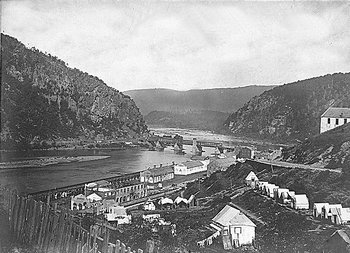
In 1861, Confederate arsenals held a total of 160,000 small arms to support an army that would grow from 750,000 to 1,000,000 men. The Union fielded forces of army, navy and marines that were at least twice the size of the enemy's comparable units. It is estimated that black Americans responding to the call to arms in the north comprised about 175,000. The ex slave, Frederick Douglass, called upon his brothers to fight for their freedom with these words:
"The rebellion can be put down without your help. Slavery can be abolished by white men, but liberty so won for the black man , while it may leave him an object of pity, can never make him an object of respect".
Both
the north and south raced to augment the supply of arms. The Confederate
government wisely sought the expertise of Pennsylvania born, West Point
trained, Josiah Gorgas, who fortuitously was married to an Alabama lady. His patriotism resided where his heart found a home. He rapidly turned a Macon Georgia laboratory
into the most successful rebel supply depot. Gorgas obtained the
services of a British chemist, James H. Burton, newly arrived from England
with manufacturing experience and plans for the production of the .58 caliber
Enfield rifle. This was the most commonly used musket by north and south.
Although still muzzle loaded, it had a rifled bore which increased range
and dramatically improved accuracy, and could be effective up to 2,000 yards.These improvements ultimately discouraged
infantry assaults over large, open fields leading to fire fights from
behind defensive redoubts (temporary fortifications). The weapon was first introduced to
British infantry in their 1853 Crimean war. It still required that the
powder (propellant) and bullet (ball) be rammed down from the muzzle
end. It had an adjustable rear sight and a fixed end sight and bayonet mounting. The technology had improved radically since the universal use of the "Brown Bess" smooth bore musket in the Revolutionary War.
Civil War Weapons

The Minie ball, named for its French inventor, was now bullet shaped (cylindrical) and capable of piercing four inches of solid wood and could drop a man on contact as well as any one standing behind him. The lead bullet produced a large, horrendous wound, and when it struck an arm or leg often only treated by amputation.
The rifled base matched the rifle bore and controlled the ball's spin when fired. Its effective explosive power was excellent up to 400 yards; some 300 yards greater than its predecessor.
Civil War Weapons
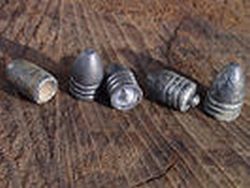 |
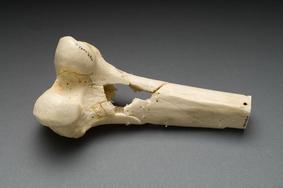 |
The Springfield rifle was American manufactured and along with the Enfield long gun was commonly used by the infantry of north and south. Here is where standardization paid off. The Minie ball was compatible to both rifles. The Enfield had finer settings for range, but the Springfield with its 40 inch length was a bargain at $20.00. At the beginning of the war, the smooth bore musket was quickly being replaced with rifled bore weapons. Springfield produced two models (1855 and 1861) with minor differences. Production in the Massachusetts armory was augmented by private manufacturers. Mass production in the north produced over 2 1/2 million Springfield rifles.
Civil War Weapons
 1855 1861 |
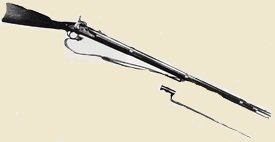 |
By the time Josiah Gorgas was promoted to brigadier general in 1864, he created a Nitre Mining Bureau that produced the gun powder for the southern armies, and promoted the utilization of such raw materials as copper and iron used in weapons production. Gorgas then supplied the raw materials to numerous southern mills. He was able to improve the rifle's domestic production significantly to about 350,000 guns, although imports amounted to over 700,000 units. History has overlooked his contribution to the rebel cause.
Ammunition shortages were a constant problem for both north and south. At the Second Battles of Bull Run (Manassas, 1862), General Jackson attacked the federal supply depot and then beat back repeated counter attacks by General Pope's Union forces. It is said, that the Confederate troops were so low in ammunition they were forced to hurl rocks at their attackers only to be saved by the timely reinforcements of General James Longstreet.
Texas, according to an 1863 Confederate congressional report, had 4 gun factories producing about 800 rifles per month in addition to 2 powder mills, a percussion factory and cartridge manufacturer in Austin. Other arsenals were located in Selma, Alabama, Atlanta, Georgia Rolling Mills, Leeds and Company, New Orleans, Louisiana, Fayetville, North Carolina. All were destroyed in the war with the exception of the Tallassee Armory in Alabama which produced carbines. Some of these facilities employed thousands of workers including working class white women and girls. A major problem confronting the south was its unskilled labor force and particularly in the operation of its weapons factories.
Civil War Weapons
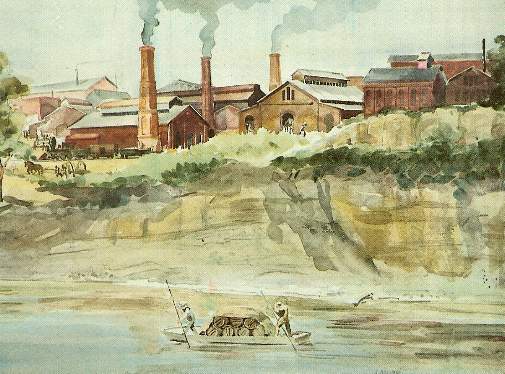 Selma Arsenal and Naval Gun Works 1865 then & now Tallassee Armory |
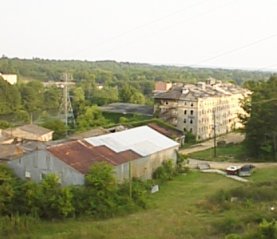 |
The Union was manufacturing shoulder held arms in its own arsenals and private mills from Massachusetts to Washington D.C. The system was overwhelmed by the new technologies that introduced the first metallic rifles and pistol cartridges. The metallic cartridge replaced the stiff paper or animal skin that were subject to weather conditions and easily damaged.
There were 17 working models of carbines, and a variety of repeating rifles.The cavalry almost exclusively used the shorter and light weight carbine. This weapon was about 18" shorter than the infantry rifle. These weapons were breech loaded (instead of front end ) with magazine fed .54 caliber, metallic cartridges. Breech loading eliminated the requirement of ramming the cartridge and propellant down the barrel from the muzzle end of the gun.
The Spencer, Sharps and Burnside
carbines were the carbines of choice Over 200,000 of these brands were
manufactured and sold to the Union army. All of these brands were
adopted by Confederate cavalry. Although these weapons were extremely popular, their utility after the war would be eclipsed with newer technologies in the next United States war.
The Burnside patent was held by the future Union general, of that name. His success as an inventor was tarnished by failures in the field.
Civil War Weapons
 Sharps Burnside |
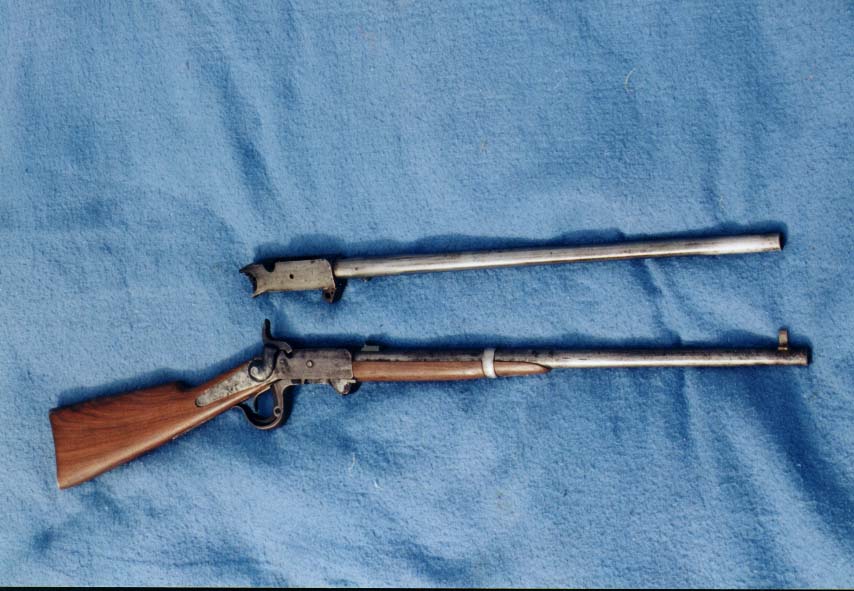 |
The Spencer was a repeating carbine. It's rapid fire was devastating. Once its 7 cartridges were loaded (required breech loading steps to prepare each chamber), its non stop repeated firing is said to have terrorized rebel troops. One such soldier captured at Chickamauga expressed shock that his foes were only a small regiment when the fire power seemed to come from a division. The image below displays a kneeling soldier firing and a standing soldier loading the cartridge into the breech of the Spencer.
Civil War Weapons
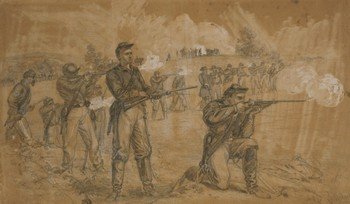
Library of Congress
The Colt and Remington brands dominated the manufacture of hand guns utilized by northern and southern armies. However, like the carbine, there were numerous other hand weapons in common use.
The Colt 1861, Navy Revolver, was manufactured in a former cotton mill. It was the preferred weapon favored by the rebels. General Nathan Bedford Forrest's horse soldiers carried a pair of .36 caliber Navy revolvers. The Union favored the Colt 1860, a.44 caliber six shooter with an attachable stock for shoulder firing.
Civil War Weapons
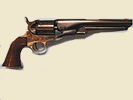 Navy Revolver 6 shooter with attachable stock. |
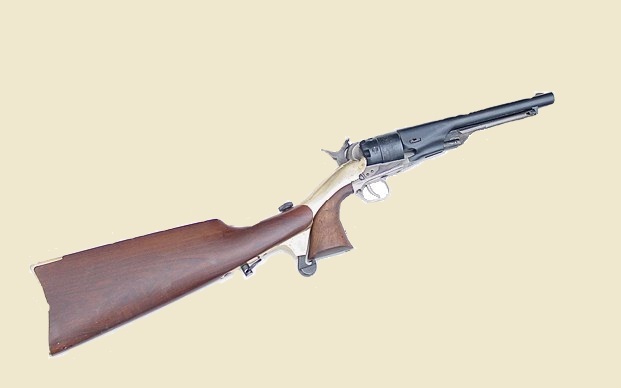 |
The cavalry had a clear preference for the percussion revolver with rotating cylinders and 5 or 6 chambers. This permitted multiple shots, but did not preclude the necessity for reloading when all the chambers were discharged. This required pouring the charge (powder) into each chamber and inserting a cap at the back of each of the chambers. When the trigger was pulled it engaged a hammer that struck the cap igniting the charge that propelled the bullet.
Despite the fact that guns in the hands of the enemy reduced the role of the cavalry, their sabres encased in leather were constantly attached to their sides. The infantry officer often discarded the sword and reserved it for the dress uniform.
Civil War Weapons
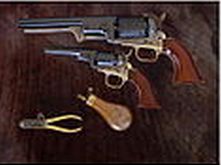 |
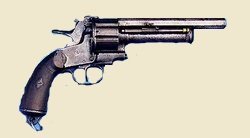 |
Remington (Colt competition) LeMat 2 barrels -Top for ball, lower for buckshot
As the war opened in 1861, both Union and Confederate armies understood the significance of the big guns in the prosecution of the war. Unlike the large defection of infantry officers to the southern cause, the Union naval officer corps remained mostly in tact. Of the 1554 naval officers, only 373 joined the Confederacy. The Union Navy rushed the purchase of thousands of pounds of iron to create impregnable ships in an age of the wooden boat. They gathered 4,000 workers and created 24 hour shifts to sheath their ships. They created iron clad, steam powered gun boats that were the equivalent of land batteries. The Confederates were also innovating. They were producing mines based on a 50 year old theory of Robert Fulton, inventor of the steam boat engine. He called the underwater explosives, "torpedoes".
General McClellan marched rebel prisoners in front of his men fearful of land "mines" in his Peninsular campaign in Virginia.
A Swedish-American, John Ericson, presented plans for an almost totally submerged ship. As a result, the Monitor was commissioned at the Brooklyn Navy Yard. Only its gun turret with its Dahlgren guns were above the water line, and the iron turret has since been salvaged after it sunk in a storm.
Civil War Weapons
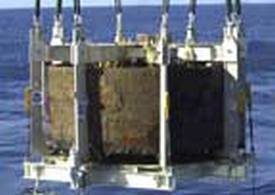
The belief that the Union Navy would be critical in determining the outcome of the war was not misplaced. An immediate study of the southern coast was undertaken and included the largest cannons in the military that guarded the American shores with its numerous, well situated forts. The guns also would be used to defend southern cities against Union bombardment from the sea. The Columbiad could project 500 pounds over 3 miles. It was also known for its great concussion when fired.
Civil War Weapons
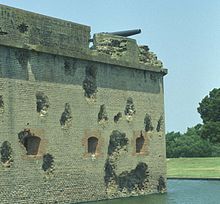 |
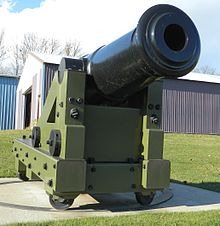 |
Georgia fort -Rodman Gun Columbiad--coastal defense gun
August/September 1863, Charleston Harbor: Union forces occupied Morris Island and immediately built a gun platform to hold the 16,000 pound Parrott gun. When completed, 13,000 sand bags were used. This cannon could propel 200 pound projectiles over four miles. An immediate message was sent to the Confederate General Beauregard demanding surrender of the city, or subject it and its population to decimation. The cannon was a known behemoth, but also had a history of malfunction in its largest version. In its smaller type, it was used successfully throughout the war and copied by the Confederates as the Brooke gun which they also utilized on their iron clad ships.
The bombardment commenced, and on the 36th shot the cannon exploded breaking its iron bands, a feature designed to prevent explosion.
Fortunately, there was little significant human carnage. Instead of a surrender, a 500 day siege began.
Famed author, Herman Melville (Moby Dick) named the the gun, "Swamp Angel".
The Confederates had their share of mistakes. The Confederate friction primer ordnance laboratory on Brown's island (Va.), on March 13, 1863, blew up leaving 68 dead and wounded working women. Three months later a Union powder magazine exploded. About the same time, the Confederate gunboat, C.S.S Chattahoochee, blew up leaving 18 dead.
Civil War Weapons
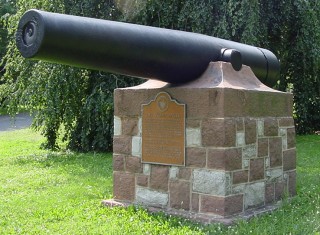 |
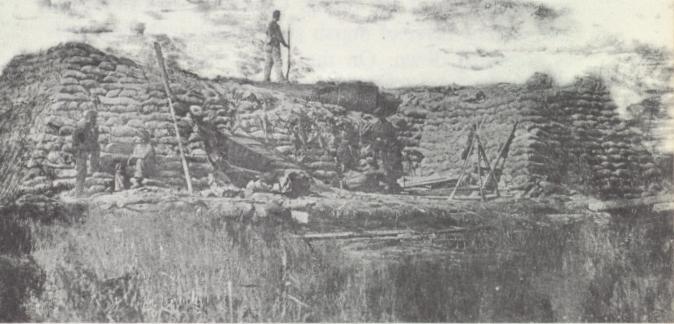 Destroyed in situ. Library of Congress |
The designs of Civil War cannons were not very complex. The Library of Congress has a basic mechanical drawing record of the field gun, howitzer, types of mortars and long rifle that supports simplicity of design. The field gun, displayed below as the Napoleon, supported infantry and cavalry in the field. The howitzer had a longer barrel than the the mortar, but shorter than the field pieces, and served a similar purpose as the mortar by projecting its load in a high arc over defensive positions. This gun also came in different weight of shot, and when lighter, more mobile than the mortar.
The mortar, weighing as much as 17,000 pounds, fired over the walls of Fort Sumter to start the war between the states. It would explode over the target and shower the enemy with shrapnel dropping at high speeds. The "Dictator" was used by the Union in its siege of Petersburg and was mounted on a reinforced railroad car.
Civil War Weapons
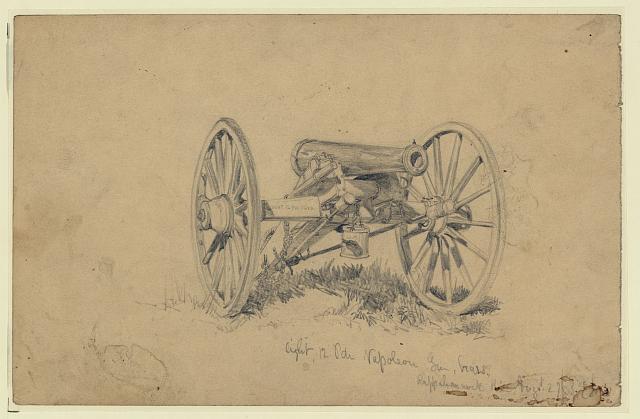 |
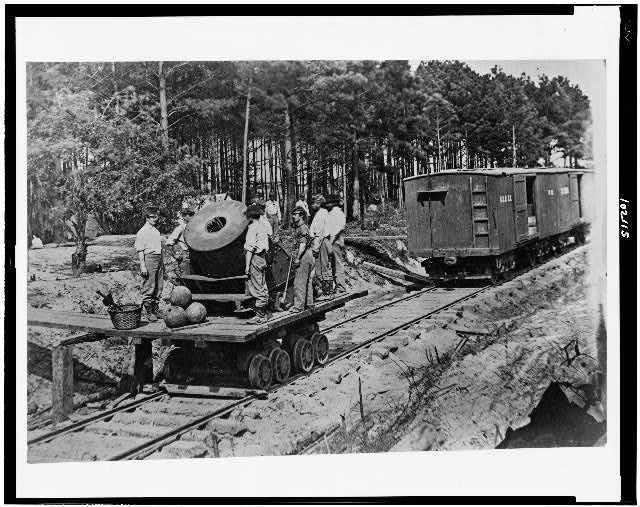 |
The war began with the Union in possession of 4,000 artillery pieces. Almost all were smooth bore which, as with hand guns, impeded range and accuracy. We indicated, above, the reluctance of many Lincoln advisers to accept new technology. Thus, it was slow to gain acceptance to refit the cannons with rifled bores.
Some carriages (caissons) weighed 3,000 pounds. Add to that the cannon size, and would require up to 6 horses to pull the load.Below is a Union horse battery and a Confederate battery at Atlanta.
Civil War Weapons
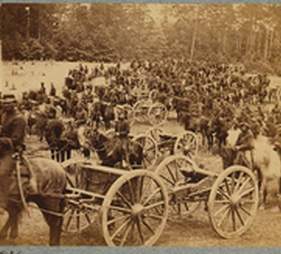 |
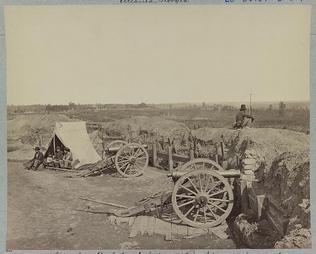 |
General Robert E. Lee had a personal preference for the English 12-pounder Whitworth. They were unique in the field because they were breech loaded with accuracy up to 2,000 yards. Some Confederate officers believed they were not the best anti infantry weapon. Below as they were lined up at Gettysburg (1863).
Civil War Weapons
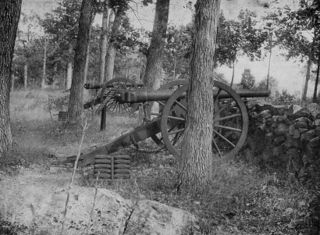
The Gatling gun, early machine gun, was patented in 1862. It featured ten rotating tubes with 40 round magazines. It was unreliable in its early development, and used sporadically in the last year of the war. We can thank Richard Gatling for gangster's referencing the term "gat".
Civil War Weapons
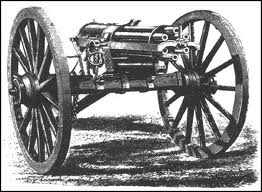
Basic engineering was adapting new methodologies. Rapidly moving men and supplies were critical. New tools and methods were necessary for quickly repairing destroyed rail lines, and were principally developed by Brigadier General Herman Haupt to counter the forays of J. E. B. Stuart's Confederate cavalry. The railroad arteries were the essential link in the supply chain.
Civil War Weapons
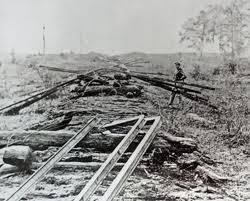
The enemy could no long escape pursuit by crossing a river and destroying the bridge behind. In the past, heavy equipment could not be transferred across a large river when a span was destroyed. During the course of the war, engineers were up to the task of rapidly building sturdy pontoon bridges to engage the enemy at full strength.
Civil War Weapons
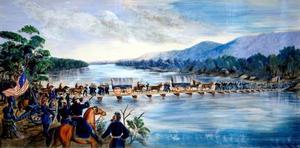 Union army at Chattanooga |
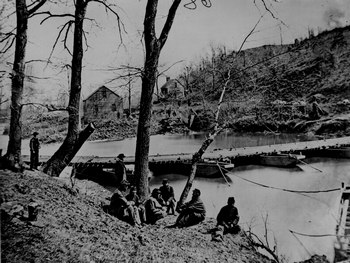 |
______________________________________________________________________
Sources and References:
Alabama Historic Iron Works Commission
civilwarguns.com
Eye Witness to the Civil War. Ed; Neil Kagan, National Geographic.Washington,D.C. Library of Congress
Library of Virginia
Long, E.B. Civil War Day By Day
McDougall,Walter A. Throes of Democracy,Harper Collins, New york, NY 2008
The American Civil War. Ed:William Coleman, Pat Perrin. Thomas Gale, Greenhaven Press, Farmington Mills, Mi 2005
Vandiver, Frank Everson, 1001 Things Everyone Should Know About the Civil War, Double Day, New York 1999.
American Wars | What Caused the Civil War | Civil War Weapons
.
.
